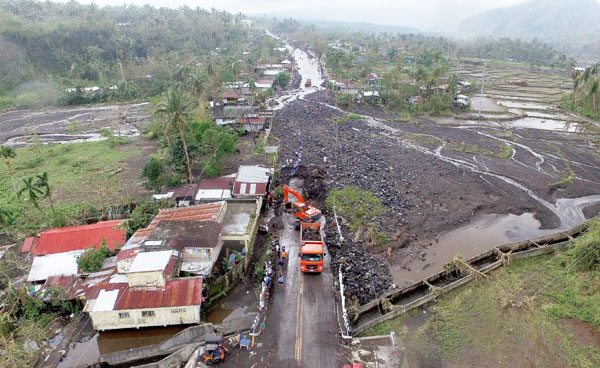RESCUERS are looking for 18 ferry crewmen missing after Typhoon “Nina” lashed Southern Luzon over the Christmas holidays, the government said Tuesday as it tried to assess the damage.
The unusually late storm first hit the Bicol provinces on Christmas Day, flooding roads and farms, destroying homes and damaging ships as it crossed the archipelago, though Metro Manila was spared.
In the worst incident, a ferry known as the MV Starlight Atlantic sank off the coastal province of Batangas, killing one and leaving 18 crewmen missing, the coast guard reported after confirming the number of people on board.
Lito Castro, an officer of the Batangas disaster monitoring council, identified the fatality as Lyca Banaynal.
Starlight Atlantic sank while seeking shelter between Tingloy in Batangas and Maricaban Island in Mindoro, between 10:20 a.m. and 11:30 a.m., after being buffeted by gale-force winds and huge waves.
Commander Raul Belusario of the Batangas Coast Guard clarified that no passengers or cargo were on board when the vessel sank, as it was seeking shelter in preparation for the typhoon.
Disasters officials feared that seven people were killed by floods and falling objects knocked down when the storm, which bore gusts of 235 kilometers an hour, hit land.
Nina took out power in the Bicol provinces, with energy officials unsure when electrical services would be restored, said Mina Marasigan, spokeswoman of the National Disaster Risk Reduction and Management Council (NDRRMC).
The power grid operator, the National Grid Corp. of the Philippines, fully restored electricity in Batangas and Quezon provinces on Tuesday.
Three Bicol provinces—Catanduanes, Albay and Camarines Sur—were placed under a state of calamity.
The NDRRMC reported that Nina affected 25,959 families or 429,485 individuals in 384 barangays in Regions IV (Calabarzon), IV-A (Mimaropa), V (Bicol) and VIII (Eastern Visayas).
Thirteen road sections and three bridges were impassable in Cagayan Valley, Mimaropa, Bicol and Eastern Visayas.
“We saw many houses destroyed by the strong winds. Infrastructure like schools and hospitals as well. We are still awaiting the exact figures of how many houses were destroyed, the exact cost of damage,” Marasigan told reporters.
Weather forecasters lowered all tropical cyclone warning signals as Nina weakened into a severe tropical storm. It was expected to be out of the country by Tuesday evening.
At the Ninoy Aquino International Airport, operations resumed after the typhoon forced the cancellation of more than 300 international and domestic flights on Monday.
‘Don’t wallow in self-pity’
President Rodrigo Duterte on Tuesday visited the provinces in the Bicol region hardest hit by Nina, promising to ensure their swift recovery.
Duterte let local officials lead the distribution of relief goods and non-food items to typhoon-stricken families in Catanduanes and Camarines Sur.
The President said the Department of Agriculture would provide seeds for planting while victims would be given P100 million worth of assistance.
“Let us not wallow in self pity; let us try to return to normalcy as soon as possible,” he said.



